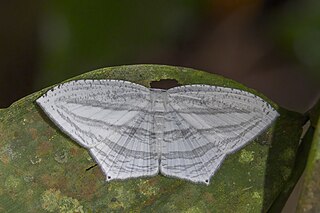
Micronia is a genus of moths of subfamily Microniinae of family Uraniidae. The genus was erected by Achille Guenée in 1857. The species of this genus are found in India, Sri Lanka, Indonesia and Papua New Guinea.

Pelochyta is a genus of moths in the family Erebidae. The species was first described by Jacob Hübner in 1819. They are found in Africa, as well as throughout India, Myanmar, Sri Lanka, Australia, and New Britain.

Arrade is a genus of moths of the family Erebidae described by Francis Walker in 1863.

Anoratha is a genus of moths of the family Erebidae described by Frederic Moore in 1867.

Arsacia is a monotypic moth genus of the family Noctuidae. Its only species is Arsacia rectalis. Both the genus and species were described by Francis Walker, the genus in 1866 and the species in 1863. It is found from the Indo-Australian tropics of India, Sri Lanka to Queensland and the Solomon Islands.
Labanda is a genus of moths of the family Nolidae erected by Francis Walker in 1859.

Catada is a genus of moths of the family Erebidae. It was first described by Francis Walker in 1859.
Chusaris is a genus of moths of the family Erebidae. It was erected by Francis Walker in 1859.

Dichromia is a genus of moths of the family Erebidae first described by Achille Guenée in 1854.
Holocryptis is a genus of moths of the family Noctuidae erected by Thomas Pennington Lucas in 1893.

Hydrillodes is a genus of litter moths of the family Erebidae first described by Achille Guenée in 1854. Its validity is somewhat disputed.
Mecistoptera is a genus of moths of the family Noctuidae first described by George Hampson in 1893.
Nagadeba is a genus of moths of the family Noctuidae first described by Francis Walker in 1866.
Niaccaba is a monotypic moth genus of the family Noctuidae first described by Francis Walker in 1866. Its single species, Niaccaba sumptualis, described by the same author one year earlier, is found in Sri Lanka, the Ryukyu Islands and Borneo.
Olulis is a genus in the moth family Erebidae. There are about eight described species in Olulis, found in South, Southeast, and East Asia, and in Australia.

Plusiodonta is a genus of moths in the family Erebidae erected by Achille Guenée in 1852.

Perina is a genus of tussock moths in the family Erebidae. It was described by Francis Walker in 1855 and is found in China, Sri Lanka and throughout India.

Corymica is a genus of moths in the family Geometridae described by Francis Walker in 1860.

Cacyparis is a genus of moths in the family Nolidae erected by Francis Walker in 1863. It is found in throughout India, Sri Lanka, Myanmar, Papua New Guinea and Australia.

Acropteris is a genus of moths of subfamily Microniinae of family Uraniidae. The genus was erected by Carl Geyer in 1832. The species of this genus are found in tropical Asia, Africa and Australia.











